tuxedo配置例子
最新weblogic与tuxedo配置详解
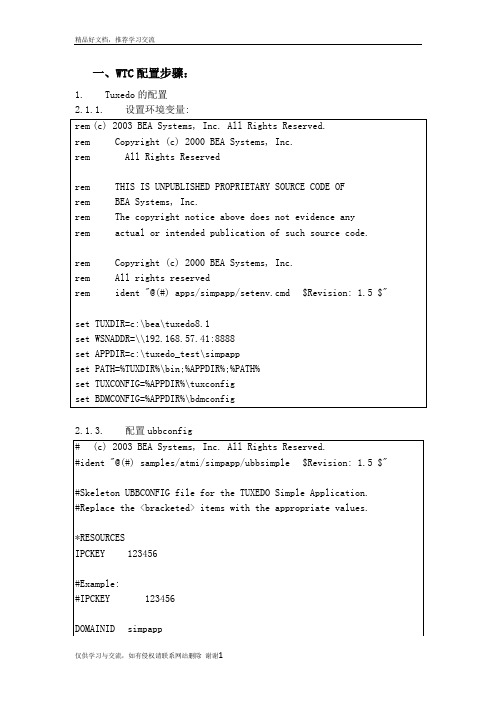
一、WTC配置步骤:1. Tuxedo的配置2.1.1. 设置环境变量:2.1.3. 配置ubbconfigMASTER simpleMAXACCESSERS 50MAXSERVERS 50MAXSERVICES 50MODEL SHMLDBAL N*MACHINESDEFAULT:APPDIR="c:\tuxedo_test\simpapp"TUXCONFIG="c:\tuxedo_test\simpapp\tuxconfig"TUXDIR="c:\bea\tuxedo8.1"#Example:# APPDIR="/home/me/simpapp"# TUXCONFIG="/home/me/simpapp/tuxconfig"# TUXDIR="/usr/tuxedo"VM44 LMID=simpleMAXWSCLIENTS=5 #指定的最大客户端连接数#Example:#beatux LMID=simple*GROUPSGROUP1 LMID=simple GRPNO=1 OPENINFO=NONEJSLGRP LMID=simple GRPNO = 2JREPGRP LMID=simple GRPNO = 3GROUP4 LMID=simple GRPNO=4 OPENINFO=NONE*SERVERSDEFAULT:CLOPT="-A"simpserv SRVGRP=GROUP1 SRVID=1WSL SRVGRP=GROUP1 SRVID=5 CLOPT="-A -t -- -n //192.168.57.41:8888 -m 2 -M 5 -x 10" #WSL发布地址JREPSVR SRVGRP=JREPGRP SRVID=10 CLOPT="-A -- -W -PC:\bea\tuxedo8.1\udataobj\jolt\repository\jrepository"红色为jolt服务需要的配置,jolt需要单独的license。
为WTC配置TUXEDO配置文件ubbconfig
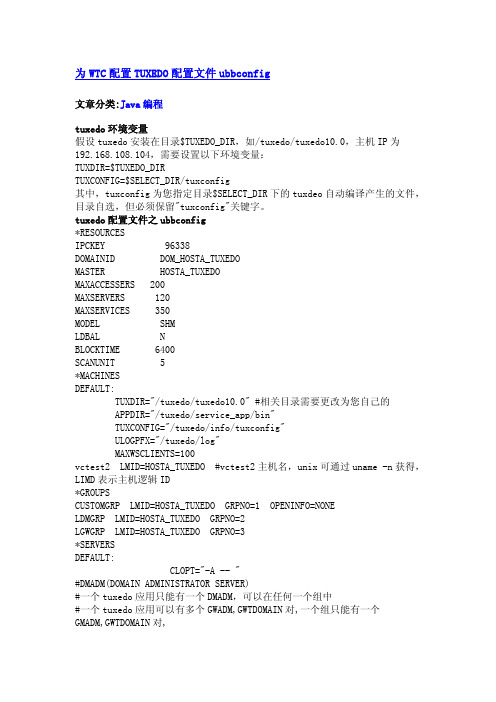
为WTC配置TUXEDO配置文件ubbconfig文章分类:Java编程tuxedo环境变量假设tuxedo安装在目录$TUXEDO_DIR,如/tuxedo/tuxedo10.0,主机IP为192.168.108.104,需要设置以下环境变量:TUXDIR=$TUXEDO_DIRTUXCONFIG=$SELECT_DIR/tuxconfig其中,tuxconfig为您指定目录$SELECT_DIR下的tuxdeo自动编译产生的文件,目录自选,但必须保留"tuxconfig"关键字。
tuxedo配置文件之ubbconfig*RESOURCESIPCKEY 96338DOMAINID DOM_HOSTA_TUXEDOMASTER HOSTA_TUXEDOMAXACCESSERS 200MAXSERVERS 120MAXSERVICES 350MODEL SHMLDBAL NBLOCKTIME 6400SCANUNIT 5*MACHINESDEFAULT:TUXDIR="/tuxedo/tuxedo10.0" #相关目录需要更改为您自己的APPDIR="/tuxedo/service_app/bin"TUXCONFIG="/tuxedo/info/tuxconfig"ULOGPFX="/tuxedo/log"MAXWSCLIENTS=100vctest2 LMID=HOSTA_TUXEDO #vctest2主机名,unix可通过uname -n获得,LIMD表示主机逻辑ID*GROUPSCUSTOMGRP LMID=HOSTA_TUXEDO GRPNO=1 OPENINFO=NONELDMGRP LMID=HOSTA_TUXEDO GRPNO=2LGWGRP LMID=HOSTA_TUXEDO GRPNO=3*SERVERSDEFAULT:CLOPT="-A -- "#DMADM(DOMAIN ADMINISTRATOR SERVER)#一个tuxedo应用只能有一个DMADM,可以在任何一个组中#一个tuxedo应用可以有多个GWADM,GWTDOMAIN对,一个组只能有一个GMADM,GWTDOMAIN对,#管理域的server,在运行时管理BDMCONFIG,对已登记的gateway group提供支持,在tuxedo系统中,只能有一个DMADM进程,#且不能对它采用MSSQ,不能有REPLYQ.DMADM SRVGRP=LDMGRP SRVID=130#GWADM(GATEWAY ADMINISTRATOR SERVER)#管理域的域网关进程,在运行时可以对某一组域网关进行管理,主要从DMADM那里取得域的配置信息,并对域网管进程#及跨越域的全局事务的LOG文件进行管理.GWADM SRVGRP=LGWGRP SRVID=140#GWTDOMIN(GATEWAY PROCESS)#处理域之前的互操作,使本地域和调用远程域可以互相调用彼此的service,其中GMADM和GWTDOMAIN必须在一个组中,#一个tuxedo应用可以有多个GWADM,GWTDOMAIN对,一个组只能有一个GMADM,GWTDOMAIN对,但一个tuxedo应用#只能有一个DMADM,DMADM可以在任何一个组中,一个本地域可以和多个远程域实现互操作.GWTDOMAIN SRVGRP=LGWGRP SRVID=150#发布的自定义服务simpserv SRVGRP=CUSTOMGRP SRVID=500 MIN=1 MAX=10 RESTART=Y MAXGEN=10 GRACE=10CLOPT="-A -r --"RQADDR="simpserv" REPLYQ=Y*SERVICESTOUPPER命令:加载ubboconfigtmloadcf -y ubbconfig关于配置WSL、JSL、JREPSVR在采用jolt方式调TUXEDO服务时必须配置,配置样例如下:*SERVERSDEFAULT:CLOPT="-A -- "WSL SRVGRP=ABMGRP SRVID=100CLOPT="-A -t -- -n //192.168.108.104:8271 -m 10 -M 200 -x 30"JSL SRVGRP=JOLTGRP SRVID=110CLOPT="-A -t -- -n //192.168.108.104:8272 -m 10 -M 200 -x 30"JREPSVR SRVGRP=JREPGRP SRVID=120GRACE=0CLOPT="-A -- -W -P$TUXDIR/udataobj/jolt/repository/jrepository"编译tuxedo自带例子simpcl.c,simpserv.c($TUXEDO_HOME/samples/atmi/simpapp)buildclient -o simpcl -f simpcl.cbuildserver -o simpserv -f simpserv.c -s TOUPPER将simpserv.o拷贝到ubbconfig中配置的APPDIR目录,这个就是我们发布的服务:DEFAULT:......simpserv SRVGRP=CUSTOMGRP SRVID=500 MIN=1 MAX=10 RESTART=Y MAXGEN=10 GRACE=10CLOPT="-A -r --"RQADDR="simpserv" REPLYQ=Y*SERVICESTOUPPER参数说明:*RESOURCES节点IPCKEY 共享内存idUID TUXEDO管理员用户idGID TUXEDO管理员组idPERM TUXEDO管理员组用户的权限MAXACCESSERS 服务端和客户端的最大进程数MAXSERVERS 限制可以启动服务总数MAXSERVICES 限制可以发布交易总数MASTER 指出主控节点的逻辑名,第二个是备份节点MODEL 应用构架,SHM表示单机,MP表示多机OPTIONS LAN,MIGRATE表示是一个网络应用,服务可以移植到替代处理器上 SECURITY 安全级别(5个)AUTHSVC 客户端可以通过交易"AUTHSVC"获得认证NOTIFY DIPIN,客户端通过dip-in收到广播通知SYSTEM_ACCESS PROTECTED,NO_OVERRIDE,应用代码不得干扰共享内存LDBAL 设Y则进行负载均衡MAXBUF[S]TYPE 数据缓冲类型及子类的最大数SCANUNIT 内部时间间隔单位,单位是秒SANITYSCAN 检索公告牌的内部时间间隔,单位是SCANUNITBLOCKTIME 交易超时时间,单位是SCANUNITBBLQUERY DBBL查询所有BLL的时间间隔DBBLWAIT DBBL等待BBL回应的超时时间MAXCONV 同时最大会话数*MACHINES MACHINES节点vctest2 物理处理器名,可以通过"uname -n"或节点名得到TUXDIR TUXEDO系统软件安装位置APPDIR 应用服务位置全路径TUXCONFIG TUXEDO配置文件全路径ENVFILE 环境文件全路径ULOGPFX 应用日志文件全路径MAXACCESSERS 本机最多处理器数,可以超越*RESOURCES节定义MAXCONV 本机最大会话数,可以超越*RESOURCES节定义*GROUPS GROUP节点BANKB1 组的唯一标识符,可以是字母数字GRPNO 组的唯一数字标识符LMID 组所在的机器*SERVERS SERVER节点,列出所有服务程序DEFAULT: 本处列出的参数为其下列出的服务的缺省值,但可以被单列条目替代相应值RESTART 如果设成Y,则服务可以重启动MAXGEN 在GRACE定义时间之内,服务可以重启动MAXGEN次GRACE 周期,单位是秒RCMD 每次服务重启动,本处定义的脚本或命令被执行ENVFILE 列有环境变量的文件,在交易启动前设入环境TLR 一个服务名,用buildserver建立,应在APPDIR或$TUXDIR/binSRVGRP 服务属于一个在*GROUPS节中定义的服务组;如果需要移植服务,也可以定义在多个组中。
TUXEDO安装部署使用排错文档
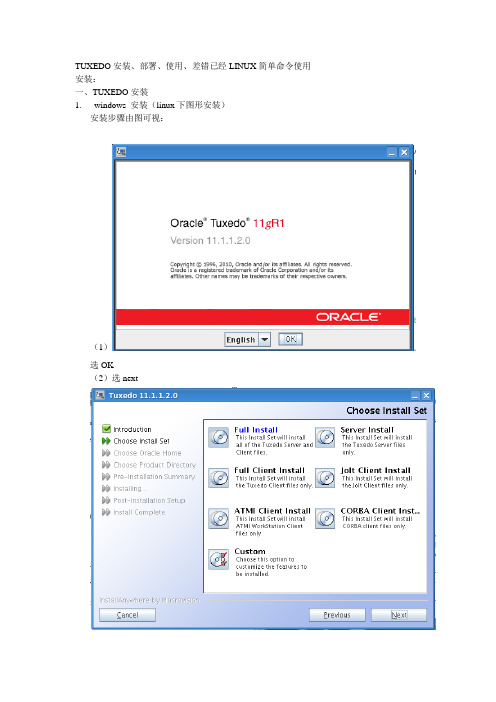
TUXEDO安装、部署、使用、差错已经LINUX简单命令使用安装:一、TUXEDO安装1.windows 安装(linux下图形安装)安装步骤由图可视:(1)选OK(2)选next(3)这是tuxedo的安装路径,放哪个目录随你自己选(4)这里最好勾选上install simples(5)选install(6)这里需先选下cancle弹出界面再选resume 然后再输入密码(7)选NO (8)选doneOK texudo就装好了2.linux下非图形界面安装(脚本安装)Tuxedo 部署流程1.将tuxedo.tar拷贝到某个目录下2.修改/opt目录权限为rwx-rwx-rwx3.解压tuxedo,tar到当前目录: tar -vxf tuxedo.tar -C ./4.运行安装脚本./install.sh5.选择16.直接回车键7.选择18.选择19.输入:/opt10.选择211.选择Y或者N12.回车13.回车14.输入两次oracle15.选择216.回车17.回车安装完成程序所在目录为当前目录下的tuxedo目录二、tuxedo部署查看虚拟机IP查看机器名称修改环境变量文件:tux.env主要设置:TUXDIR,PATH,LD_LIBRARY_PA TH,LANG,APPDIR修改UBB配置文件(c) 2003 BEA Systems, Inc. All Rights Reserved.#ident "@(#) samples/atmi/simpapp/ubbsimple $Revision: 1.7 $"#Skeleton UBBCONFIG file for the TUXEDO Simple Application.#Replace the <bracketed> items with the appropriate values.*RESOURCESIPCKEY 123456 (1)DOMAINID simpappMASTER serverMAXACCESSERS 100MAXSERVERS 50MAXSERVICES 50MODEL SHMLDBAL NNOTIFY SIGNAL*MACHINESDEFAULT: (2)APPDIR="/home/oracle/simpapp"TUXCONFIG="/home/oracle/simpapp/tuxconfig"TUXDIR="/home/oracle/tuxedo11gR1"MAXWSCLIENTS=5#Example:# APPDIR="/home/me/simpapp"# TUXCONFIG="/home/me/simpapp/tuxconfig"# TUXDIR="/usr/tuxedo""bogon130" LMID=server#Example:#beatux LMID=iogon*GROUPSGROUP1 (3)LMID=server GRPNO=1 OPENINFO=NONE*SERVERSDEFAULT:CLOPT="-A"forward SRVGRP=GROUP1 SRVID=10 (4)toupper SRVGRP=GROUP1 SRVID=1WSL SRVGRP=GROUP1 SRVID=20 (5)CLOPT="-A -- -n //192.168.192.130:9977 -m 2 -M 5 -x 10 -p 10000 -P 11000"*SERVICES (6)TOUPPERTOUPPERTEST(1)IPC资源识别号设置(2)服务器程序环境设置(3)服务器组设置(4)服务设置(5)通讯设置(6)服务名设置设置环境变量. ./tux.env编译程序配置文件tmloadcf –y ubb启动程序tmboot建议:1.关闭服务器防火墙,或者设置通讯端口开发,WSH端口段开开放2.Selinux设置为不启动3.启动程序以后在客户端使用telnet命令测试连接是否成功。
TUXEDO配置参数详解
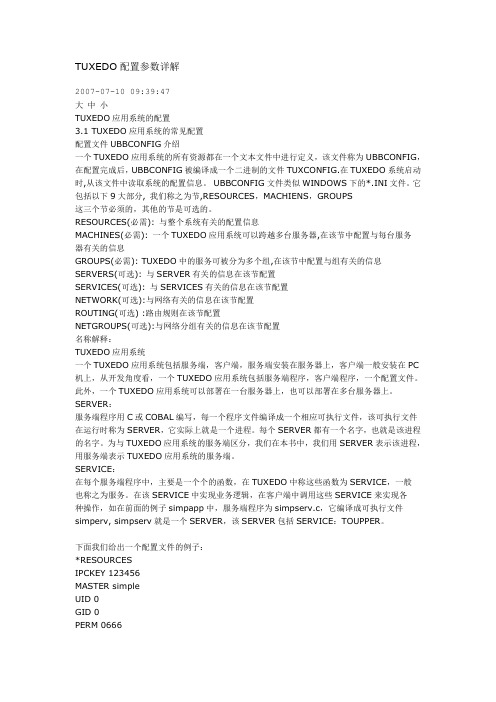
TUXEDO配置参数详解2007-07-10 09:39:47大中小TUXEDO应用系统的配置3.1 TUXEDO应用系统的常见配置配置文件UBBCONFIG介绍一个TUXEDO应用系统的所有资源都在一个文本文件中进行定义,该文件称为UBBCONFIG,在配置完成后,UBBCONFIG被编译成一个二进制的文件TUXCONFIG.在TUXEDO系统启动时,从该文件中读取系统的配置信息。
UBBCONFIG文件类似WINDOWS下的*.INI文件。
它包括以下9大部分, 我们称之为节,RESOURCES,MACHIENS,GROUPS这三个节必须的,其他的节是可选的。
RESOURCES(必需): 与整个系统有关的配置信息MACHINES(必需): 一个TUXEDO应用系统可以跨越多台服务器,在该节中配置与每台服务器有关的信息GROUPS(必需): TUXEDO中的服务可被分为多个组,在该节中配置与组有关的信息SERVERS(可选): 与SERVER有关的信息在该节配置SERVICES(可选): 与SERVICES有关的信息在该节配置NETWORK(可选):与网络有关的信息在该节配置ROUTING(可选) :路由规则在该节配置NETGROUPS(可选):与网络分组有关的信息在该节配置名称解释:TUXEDO应用系统一个TUXEDO应用系统包括服务端,客户端,服务端安装在服务器上,客户端一般安装在PC 机上,从开发角度看,一个TUXEDO应用系统包括服务端程序,客户端程序,一个配置文件。
此外,一个TUXEDO应用系统可以部署在一台服务器上,也可以部署在多台服务器上。
SERVER:服务端程序用C或COBAL编写,每一个程序文件编译成一个相应可执行文件,该可执行文件在运行时称为SERVER,它实际上就是一个进程。
每个SERVER都有一个名字,也就是该进程的名字。
为与TUXEDO应用系统的服务端区分,我们在本书中,我们用SERVER表示该进程,用服务端表示TUXEDO应用系统的服务端。
Linux下安装Tuxedo
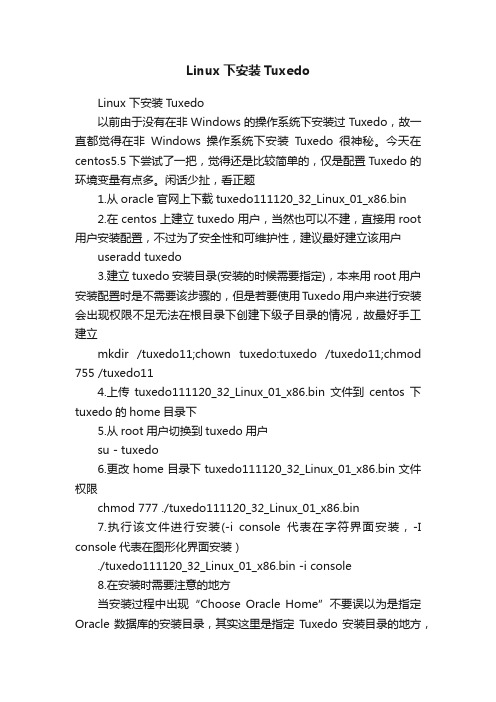
Linux下安装TuxedoLinux 下安装Tuxedo以前由于没有在非Windows的操作系统下安装过Tuxedo,故一直都觉得在非Windows操作系统下安装Tuxedo很神秘。
今天在centos5.5下尝试了一把,觉得还是比较简单的,仅是配置Tuxedo的环境变量有点多。
闲话少扯,看正题1.从oracle 官网上下载tuxedo111120_32_Linux_01_x86.bin2.在centos上建立tuxedo用户,当然也可以不建,直接用root 用户安装配置,不过为了安全性和可维护性,建议最好建立该用户useradd tuxedo3.建立tuxedo 安装目录(安装的时候需要指定),本来用root用户安装配置时是不需要该步骤的,但是若要使用Tuxedo用户来进行安装会出现权限不足无法在根目录下创建下级子目录的情况,故最好手工建立mkdir /tuxedo11;chown tuxedo:tuxedo /tuxedo11;chmod 755 /tuxedo114.上传tuxedo111120_32_Linux_01_x86.bin文件到centos下tuxedo的home目录下5.从root用户切换到tuxedo用户su - tuxedo6.更改home目录下tuxedo111120_32_Linux_01_x86.bin文件权限chmod 777 ./tuxedo111120_32_Linux_01_x86.bin7.执行该文件进行安装(-i console代表在字符界面安装,-I console代表在图形化界面安装)./tuxedo111120_32_Linux_01_x86.bin -i console8.在安装时需要注意的地方当安装过程中出现“Choose Oracle Home”不要误以为是指定Oracle数据库的安装目录,其实这里是指定Tuxedo安装目录的地方,将在第3步建立的目录名称填到“specify a new Oracle Home Directory”处即可;还有如果你想玩一下tuxedo的simpapp的话,在安装的时候必须选上“Install Sample”;其余选项一路回车即可完成安装安装到此结束以下是配置simpapp的一些过程,以下操作均在tuxedo用户下运行1.cp -R /tuxedo11/tuxedo11g/simples/atim/simpapp /home/tuxedo/2.cp -R /tuxedo11/tuxedo11g/tux.env /home/tuxedo/simpapp3.cd ./simpapp;vi ./tux.env#若需要使用Oracle数据库时需添加ORACLE_BASE=/u01/app/oracle;export ORACLE_BASE#若需要使用Oracle数据库时需添加ORACLE_HOME=$ORACLE_BASE/product/11g2/db_1;export ORACLE_HOME#若需要使用Oracle数据库时需添加ORACLE_SID=oracle11g2;export ORACLE_SIDTUXDIR=/tuxedo11/tuxedo11gR1; export TUXDIRJA V A_HOME=$TUXDIR/jre; export JA V A_HOMEJVMLIBS=$JA V A_HOME/lib/i386/server:$JA V A_HOME/jre/binPA TH=$TUXDIR/bin:$JA V A_HOME/bin:$ORACLE_HOME/bin:$PA TH; export PA TH COBCPY=:$TUXDIR/cobinclude; export COBCPYCOBOPT="-C ANS85 -C ALIGN=8 -C NOIBMCOMP -C TRUNC=ANSI -C OSEXT=cbl"; export COBOPTSHLIB_PA TH=$TUXDIR/lib:$JVMLIBS:$SHLIB_PA TH; export SHLIB_PA THLIBPA TH=$TUXDIR/lib:$JVMLIBS:$LIBPA TH; export LIBPA THLD_LIBRARY_PATH=$TUXDIR/lib:$JVMLIBS:$ORACLE_HOME/lib:$ORACLE_HOM E/ora cm/lib:/lib:/usr/lib:/usr/local/lib:$LD_LIBRARY_PA TH; export LD_LIBRARY_PA THWEBJA V ADIR=$TUXDIR/udataobj/webgui/java; export WEBJA V ADIR#若运行simpapp时需添加APPDIR=/home/tuxedo/simpapp;export APPDIR#若运行simpapp时需添加TUXCONFIG=$APPDIR/tuxconfig;export TUXCONFIGNLS_LANG=AMERICAN_AMERICA.UTF8;export NLS_LANG LANG=C;export LANG这个环境变量文件包含了与Oracle连接的环境变量,仅执行simpapp时不需要添加;但下面的有关simpapp的环境变量必须添加,否则运行时会出错4.编辑simpapp的配置文件,其中“dcsproject”是centos的主机名,你可以根据你的主机名做相应更改,其中最后的“TOUPPER”是配置文件服务名称,从字面含义可以看出,他的功能就是简单的客户端输入的小写字母转换为大写字母# (c) 2003 BEA Systems, Inc. All Rights Reserved.#ident "@(#) samples/atmi/simpapp/ubbsimple $Revision: 1.7 $"#Skeleton UBBCONFIG file for the TUXEDO Simple Application.#Replace the items with the appropriate values.*RESOURCESIPCKEY 123456#Example:#IPCKEY 123456DOMAINID simpappMASTER simpleMAXACCESSERS 10MAXSERVERS 5MAXSERVICES 10MODEL SHMLDBAL N*MACHINESDEFAULT:APPDIR="/home/tuxedo/simpapp"TUXCONFIG="/home/tuxedo/simpapp/tuxconfig" TUXDIR="/tuxedo11/tuxedo11gR1"#Example:# APPDIR="/home/me/simpapp"# TUXCONFIG="/home/me/simpapp/tuxconfig"# TUXDIR="/usr/tuxedo"dcsproject LMID=simple#Example:#beatux LMID=simple*GROUPSGROUP1LMID=simple GRPNO=1 OPENINFO=NONE*SERVERSDEFAULT:CLOPT="-A"simpserv SRVGRP=GROUP1 SRVID=1*SERVICESTOUPPER5.运行环境变量文件,编译编辑后的ubb文件,生成tuxconfig文件. ./tux.envenv|grep TUX(检查一下环境变量)tmloadcf -y ubbls(j检查有没有生成tuxconfig文件)6.编译simpapp的SERVER端及Client端程序,生成可执行文件buildserver -f simpserv.c -o simpserv -s TOUPPER(-f 参数表示第一个输入文件-o 参数表示输出文件-s 参数表示服务)buildclient -f simpcl.c -o simpcl7.检查文件有无生成ls7.运行服务器端程序tmboot -y8.测试./simpcl hello_bigbombpanda若回显为:Returned String is:HELLO_BIGBOMBPANDA成功至于如何让tuxedo和Oracle数据库联动工作,首先要弄清楚XA,NONXA的连接方式。
tuxedo培训教程

引言:本文是关于Tuxedo培训教程的第二部分,旨在深入介绍Tuxedo技术的相关知识和应用。
Tuxedo是一种高性能、高可用性的分布式应用服务器,广泛应用于大规模事务处理和企业级应用领域。
本文将分为五个方面对Tuxedo进行详细阐述,帮助读者更好地理解和应用该技术。
正文:一、Tuxedo安装与配置1. Tuxedo系统要求:包括硬件和软件要求,例如操作系统、内存、存储等方面的要求。
2. Tuxedo的安装步骤:详细介绍如何下载、安装和配置Tuxedo软件。
3. Tuxedo的配置文件:包括DOMAINS、UBBCONFIG等配置文件的作用和常用参数设置。
4. Tuxedo的环境变量设置:介绍如何设置Tuxedo相关的环境变量,确保系统能正常运行。
二、Tuxedo应用开发1. Tuxedo编程模型:介绍Tuxedo的编程模型,包括服务(Service)、服务器(Server)和客户端(Client)的概念和作用。
2. Tuxedo事务管理:详细解释Tuxedo事务的概念和使用方法,包括事务的起始、提交和回滚操作。
3. Tuxedo服务开发:介绍如何编写和发布Tuxedo服务,包括服务的注册、发布和请求处理过程。
4. Tuxedo客户端开发:讲解如何编写Tuxedo客户端程序,包括连接Tuxedo服务、发送请求和接收响应等步骤。
5. Tuxedo编程示例:通过实际的编程示例演示Tuxedo应用开发的流程和技巧,帮助读者更好地理解和应用。
三、Tuxedo监控与调优1. Tuxedo监控工具:介绍Tuxedo自带的监控工具,如tmadmin和tmj,用于监控和管理Tuxedo域。
2. Tuxedo性能调优:给出一些Tuxedo性能调优的建议和方法,包括资源配置、线程池设置等方面。
3. Tuxedo故障排查:介绍常见的Tuxedo故障和排查方法,如错误日志分析、日志级别配置等。
4. Tuxedo性能分析:介绍常用的性能分析工具和方法,用于定位和解决Tuxedo应用的性能瓶颈问题。
TUXEDO配置参数详解
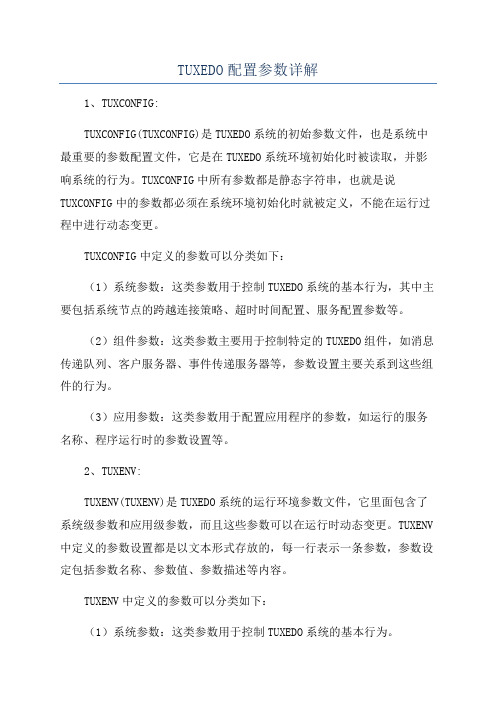
TUXEDO配置参数详解
1、TUXCONFIG:
TUXCONFIG(TUXCONFIG)是TUXEDO系统的初始参数文件,也是系统中最重要的参数配置文件,它是在TUXEDO系统环境初始化时被读取,并影响系统的行为。
TUXCONFIG中所有参数都是静态字符串,也就是说TUXCONFIG中的参数都必须在系统环境初始化时就被定义,不能在运行过程中进行动态变更。
TUXCONFIG中定义的参数可以分类如下:
(1)系统参数:这类参数用于控制TUXEDO系统的基本行为,其中主要包括系统节点的跨越连接策略、超时时间配置、服务配置参数等。
(2)组件参数:这类参数主要用于控制特定的TUXEDO组件,如消息传递队列、客户服务器、事件传递服务器等,参数设置主要关系到这些组件的行为。
(3)应用参数:这类参数用于配置应用程序的参数,如运行的服务名称、程序运行时的参数设置等。
2、TUXENV:
TUXENV(TUXENV)是TUXEDO系统的运行环境参数文件,它里面包含了系统级参数和应用级参数,而且这些参数可以在运行时动态变更。
TUXENV 中定义的参数设置都是以文本形式存放的,每一行表示一条参数,参数设定包括参数名称、参数值、参数描述等内容。
TUXENV中定义的参数可以分类如下:
(1)系统参数:这类参数用于控制TUXEDO系统的基本行为。
tuxedo命令和配置的详细解释及应用实例

tuxedo命令和配置的详细解释及应用实例域的组成BDMCONFIG:二进制配置文件DMADM:域管理服务器,管理多个GWADMGWADM:运行时网关管理服务器,从DMADM服务器上获取域信息GWTDOMAIN:是一个网关进程,在域之间转发消息tmshutdown/tmboot -s 服务名按服务名停/启单个服务tmshutdown/tmboot -S (大写的S)停/启所有服务tmshutdown/tmboot -i 进程号按进程号停/启单个服务tmshutdown/tmboot -g 组名字按组停/启服务tmshutdown/tmboot -y -w1 按用户停/启服务tmloadcf -n 文件名只做语法检查不编译tmloadcf -y 文件名编译二进制文件tmloadcf -c 文件名测试IPC资源最小需求tmadmin -v 版本tmadmin>bbp 查BB的参数bbs BB统计信息pclt 连接客户端信息psr server信息psc service信息pt 当前事物信息pq 队列信息echo psr|tmadmin|grep -v IDLEecho psr|tmadmin|sort +4echo psc|tmadmin|sort +6echo pq|tmadmin|sort +4echo pclt|tmadmin|grep -v WSH|grep -v tmadmin以下是tmadmin命令的printserver(简写为psr)的简单输出。
列号描述1. 服务的可执行文件名2. 服务连接的队列名3. 组名4. 服务的数字id5. 服务已经处理的请求数6. 服务处理的全部请求的参数和7. 服务正在处理的交易,若为IDLE则服务当前是空闲ccsmis:/home2/ccsmis>tmadmintmadmin - Copyright (c) 1996 BEA Systems, Inc.Portions * Copyright 1986-1997 RSA Data Security, Inc.All Rights Reserved.Distributed under license by BEA Systems, Inc.Tuxedo is a registered trademark.> printserverProg Name Queue Name Grp Name ID RqDone Load Done Current Service --------- ---------- -------- -- ------ --------- --------------- rz_Ecsb 00004.04000 APGP2 4000 0 0 ( IDLE )BBL 70020 simple 0 1 50 ( IDLE ) IFMTMS APGP2_TMS APGP2 30001 1 50 ( IDLE )交易信息来自GAI的信息本处略去。
tuxedo本地和远程客户端
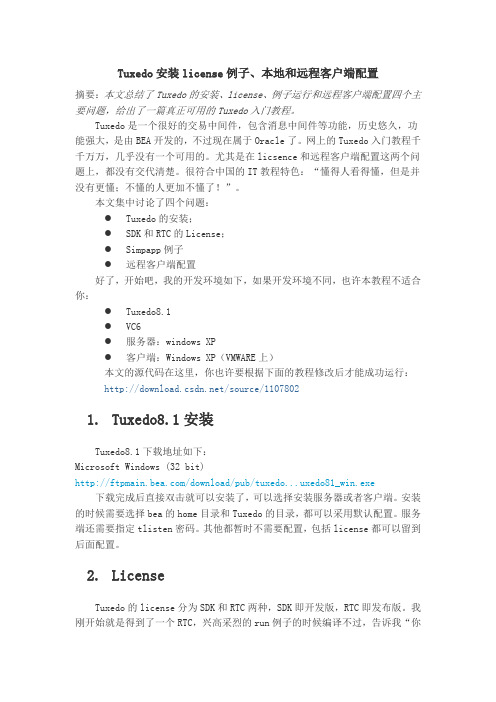
Tuxedo安装license例子、本地和远程客户端配置摘要:本文总结了Tuxedo的安装、license、例子运行和远程客户端配置四个主要问题,给出了一篇真正可用的Tuxedo入门教程。
Tuxedo是一个很好的交易中间件,包含消息中间件等功能,历史悠久,功能强大,是由BEA开发的,不过现在属于Oracle了。
网上的Tuxedo入门教程千千万万,几乎没有一个可用的。
尤其是在licsence和远程客户端配置这两个问题上,都没有交代清楚。
很符合中国的IT教程特色:“懂得人看得懂,但是并没有更懂;不懂的人更加不懂了!”。
本文集中讨论了四个问题:●Tuxedo的安装;●SDK和RTC的License;●Simpapp例子●远程客户端配置好了,开始吧,我的开发环境如下,如果开发环境不同,也许本教程不适合你:●Tuxedo8.1●VC6●服务器:windows XP●客户端:Windows XP(VMWARE上)本文的源代码在这里,你也许要根据下面的教程修改后才能成功运行:/source/11078021.Tuxedo8.1安装Tuxedo8.1下载地址如下:Microsoft Windows (32 bit)/download/pub/tuxedo...uxedo81_win.exe 下载完成后直接双击就可以安装了,可以选择安装服务器或者客户端。
安装的时候需要选择bea的home目录和Tuxedo的目录,都可以采用默认配置。
服务端还需要指定tlisten密码。
其他都暂时不需要配置,包括license都可以留到后面配置。
2.LicenseTuxedo的license分为SDK和RTC两种,SDK即开发版,RTC即发布版。
我刚开始就是得到了一个RTC,兴高采烈的run例子的时候编译不过,告诉我“你没有一个合法的SDK license”。
其实bea已经公布了所有的license,直接去官方网站下载就可以了,不要到处找所谓的无限制xx license,Tuxedo8.1的SDK license地址如下:/downloads/LIC-TUX81-SDK-56B.zip下载后解压,将文件名改为lic.txt,然后拷贝到TUXEDO_HOME/udataobj 目录下面就可以了。
TUXEDO简介及命令介绍
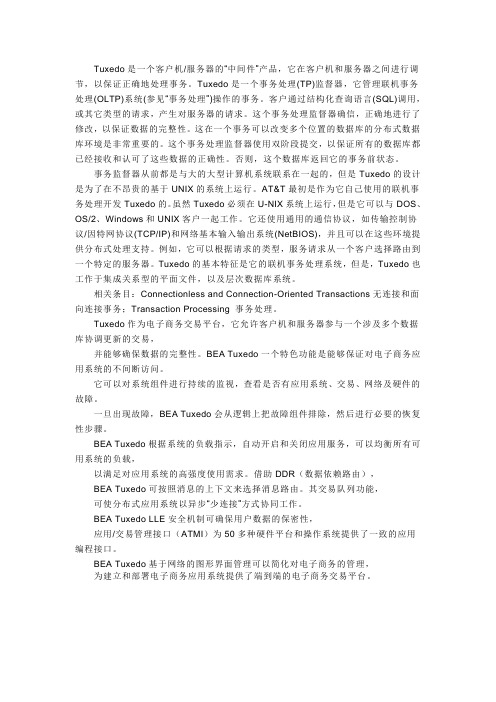
Tuxedo是一个客户机/服务器的―中间件‖产品,它在客户机和服务器之间进行调节,以保证正确地处理事务。
Tuxedo是一个事务处理(TP)监督器,它管理联机事务处理(OLTP)系统(参见―事务处理‖)操作的事务。
客户通过结构化查询语言(SQL)调用,或其它类型的请求,产生对服务器的请求。
这个事务处理监督器确信,正确地进行了修改,以保证数据的完整性。
这在一个事务可以改变多个位置的数据库的分布式数据库环境是非常重要的。
这个事务处理监督器使用双阶段提交,以保证所有的数据库都已经接收和认可了这些数据的正确性。
否则,这个数据库返回它的事务前状态。
事务监督器从前都是与大的大型计算机系统联系在一起的,但是Tuxedo的设计是为了在不昂贵的基于UNIX的系统上运行。
AT&T最初是作为它自己使用的联机事务处理开发Tuxedo的。
虽然Tuxedo必须在U-NIX系统上运行,但是它可以与DOS、OS/2、Windows和UNIX客户一起工作。
它还使用通用的通信协议,如传输控制协议/因特网协议(TCP/IP)和网络基本输入输出系统(NetBIOS),并且可以在这些环境提供分布式处理支持。
例如,它可以根据请求的类型,服务请求从一个客户选择路由到一个特定的服务器。
Tuxedo的基本特征是它的联机事务处理系统,但是,Tuxedo也工作于集成关系型的平面文件,以及层次数据库系统。
相关条目:Connectionless and Connection-Oriented Transactions无连接和面向连接事务;Transaction Processing 事务处理。
Tuxedo作为电子商务交易平台,它允许客户机和服务器参与一个涉及多个数据库协调更新的交易,并能够确保数据的完整性。
BEA Tuxedo一个特色功能是能够保证对电子商务应用系统的不间断访问。
它可以对系统组件进行持续的监视,查看是否有应用系统、交易、网络及硬件的故障。
TUXEDO+JOLT配置与编程简介
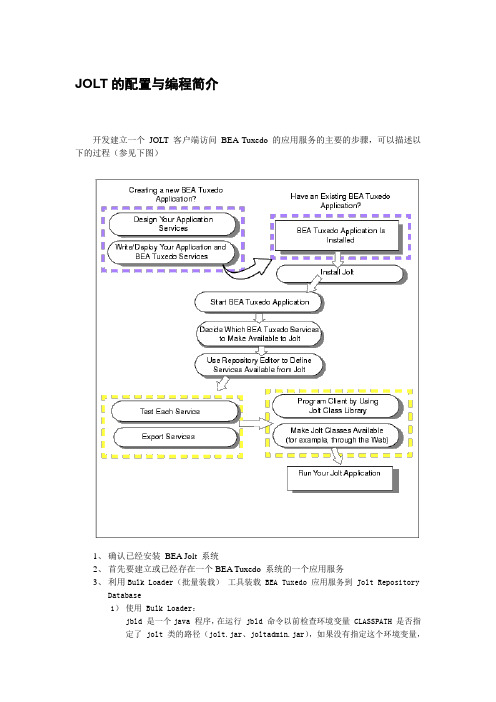
JOLT的配置与编程简介开发建立一个JOLT 客户端访问BEA Tuxedo 的应用服务的主要的步骤,可以描述以下的过程(参见下图)1、确认已经安装BEA Jolt 系统2、首先要建立或已经存在一个BEA Tuxedo 系统的一个应用服务3、利用Bulk Loader(批量装载)工具装载 BEA Tuxedo 应用服务到 Jolt RepositoryDatabase1)使用 Bulk Loader:jbld 是一个java 程序,在运行 jbld 命令以前检查环境变量 CLASSPATH 是否指定了 jolt 类的路径(jolt.jar、joltadmin.jar),如果没有指定这个环境变量,java 虚拟机不能够定位到任何的 jolt classes** 激活Bulk Loader:在提示符下输入以下命令(带上正确的选择项):java bea.jolt.admin.jbld [-n][-p package][-u usrname][-r usrrole]//host:port filename**批量装载文件- the Bulk Loader FileBulk Loader File 是一个定义服务和关联参数文本文件,Bulk Loader装载定义在the Bulk Loader File(批量装载文件)中的服务到 jolt 接口服务库中(默认的包是:BULKPKG)。
2) Bulk Loader File 的语法每一个服务定义是由服务属性和参数组成的:属性和参数都有一个要设置的数字,每一个属性描绘都通过一个关键字和一个值关键字分为两层:◎Service_level (服务层)◎Parameter_level (参数层)* 关键字的指导方针* jbld 程序读取服务定义文本文件,关键字的用法遵守下表的指导方针:◎在Bulk Loader 文本文件中关键字的顺序一个服务定义必须以service=<SERVICE_NAME> 开始,服务如果是采用CARRAY 或者是STRING 类型的BUFFER,在服务中只有一个参数。
TUXEDO配置参数详解
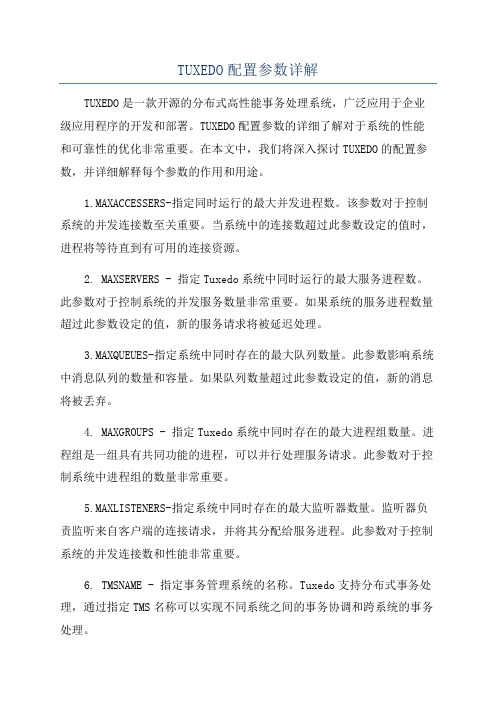
TUXEDO配置参数详解TUXEDO是一款开源的分布式高性能事务处理系统,广泛应用于企业级应用程序的开发和部署。
TUXEDO配置参数的详细了解对于系统的性能和可靠性的优化非常重要。
在本文中,我们将深入探讨TUXEDO的配置参数,并详细解释每个参数的作用和用途。
1.MAXACCESSERS-指定同时运行的最大并发进程数。
该参数对于控制系统的并发连接数至关重要。
当系统中的连接数超过此参数设定的值时,进程将等待直到有可用的连接资源。
2. MAXSERVERS - 指定Tuxedo系统中同时运行的最大服务进程数。
此参数对于控制系统的并发服务数量非常重要。
如果系统的服务进程数量超过此参数设定的值,新的服务请求将被延迟处理。
3.MAXQUEUES-指定系统中同时存在的最大队列数量。
此参数影响系统中消息队列的数量和容量。
如果队列数量超过此参数设定的值,新的消息将被丢弃。
4. MAXGROUPS - 指定Tuxedo系统中同时存在的最大进程组数量。
进程组是一组具有共同功能的进程,可以并行处理服务请求。
此参数对于控制系统中进程组的数量非常重要。
5.MAXLISTENERS-指定系统中同时存在的最大监听器数量。
监听器负责监听来自客户端的连接请求,并将其分配给服务进程。
此参数对于控制系统的并发连接数和性能非常重要。
6. TMSNAME - 指定事务管理系统的名称。
Tuxedo支持分布式事务处理,通过指定TMS名称可以实现不同系统之间的事务协调和跨系统的事务处理。
7.GWADMINSERVERS-指定在系统启动时自动启动的网关管理服务器数量。
网关管理服务器通过网关提供与外部系统的通信能力。
此参数对于控制网关管理服务器数量非常重要。
8. MAXBUFTYPE - 指定系统中支持的最大缓冲区类型数量。
Tuxedo 支持多种不同类型的缓冲区,用于在系统内部传递数据。
此参数影响系统中缓冲区的数量和类型。
9. MAXNIPROC - 指定系统中支持的最大网络通讯进程数。
Tuxedo在银行业的应用2
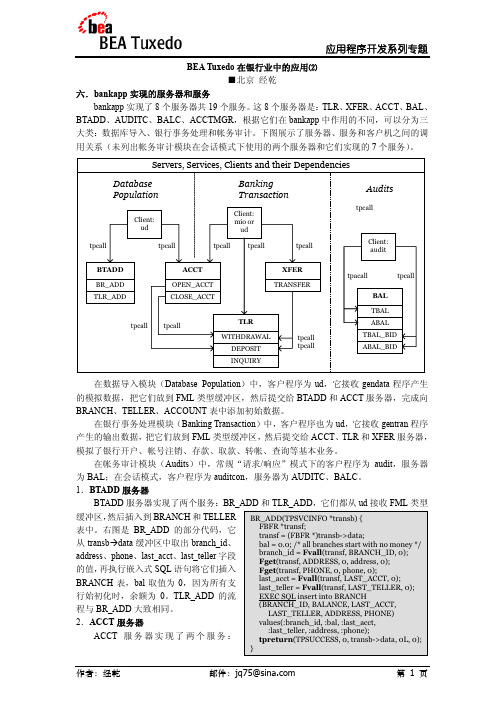
BEA Tuxedo 在银行业中的应用⑵■北京 经乾六.bankapp 实现的服务器和服务bankapp 实现了8个服务器共19个服务。
这8个服务器是:TLR 、XFER 、ACCT 、BAL 、BTADD 、AUDITC 、BALC 、ACCTMGR ,根据它们在bankapp 中作用的不同,可以分为三大类:数据库导入、银行事务处理和帐务审计。
下图展示了服务器、服务和客户机之间的调用关系(未列出帐务审计模块在会话模式下使用的两个服务器和它们实现的7个服务)。
在数据导入模块(Database Population )中,客户程序为ud ,它接收gendata 程序产生的模拟数据,把它们放到FML 类型缓冲区,然后提交给BTADD 和ACCT 服务器,完成向BRANCH 、TELLER 、ACCOUNT 表中添加初始数据。
在银行事务处理模块(Banking Transaction )中,客户程序也为ud ,它接收gentran 程序产生的输出数据,把它们放到FML 类型缓冲区,然后提交给ACCT 、TLR 和XFER 服务器,模拟了银行开户、帐号注销、存款、取款、转帐、查询等基本业务。
在帐务审计模块(Audits )中,常规“请求/响应”模式下的客户程序为audit ,服务器为BAL ;在会话模式,客户程序为auditcon ,服务器为AUDITC 、BALC 。
1.BTADD 服务器BTADD 服务器实现了两个服务:BR_ADD 和TLR_ADD ,它们都从ud 接收FML 类型缓冲区,然后插入到BRANCH 和TELLER 表中。
右图是BR_ADD 的部分代码,它从transb Ædata 缓冲区中取出branch_id 、address 、phone 、last_acct 、last_teller 字段的值,再执行嵌入式SQL 语句将它们插入BRANCH 表,bal 取值为0,因为所有支行始初化时,余额为0。
tuxedo基本命令详细说明

1 tmloadcf➢检查UBBCONFIG文件的内容及格式➢将文本格式的UBBCONFIG文件编译生成二进制文件➢必须在主机上运行➢格式tmloadcf [-n] [-y] [-c] [-b blocks] {UBBCONFIG_file | -}➢参数-c 计算最小的IPC需求-n 仅仅进行UBBCONFIG文件的内容检查,不生成二进制文件-y 覆盖已有的二进制文件之前不提示-b blocks 如果环境变量TUXCONFIG所指的文件存放在一个裸设备上,建议使用该参数;如果该文件存放在文件系统上,则不需要2 tmunloadcf➢将二进制TUXCONFIG文件反编译为文本格式3 tmipcrm➢清除本机上的IPC资源➢自动根据TUXCONFIG_file参数查找相应的IPC资源➢一般在Tuxedo非正常停止的情况下用来清理残留IPC资源➢格式tmipcrm [-y] [-n] [TUXCONFIG_file]➢参数-y 对命令运行过程中的询问回答y-n 不清除IPC资源,只是列出IPC资源TUXCONFIG_file Tuxedo的配置文件。
如果不指定,则使用环境变量TUXCONFIG4 tmboot➢启动Tuxedo➢格式tmboot [-l lmid] [-g grpname] [-i srvid] [-s aout] [-o sequence][-S] [-A] [-b] [-B lmid] [-T grpname] [-e command] [-w] [-y] [-g][-n] [-c] [-M] [-d1]➢参数-l lmid 启动所有绑定到这个逻辑主机的服务,包括应用Server、TMS、Gateway等等-g grpname 启动grpname包含的所有服务,包括应用Server、TMS等-i srvid 启动所有SRVID为srvid的服务-s aout 启动Server名字为aout的服务,也可以用来启动TMS、Gateway等服务。
Linux 下tuxedo
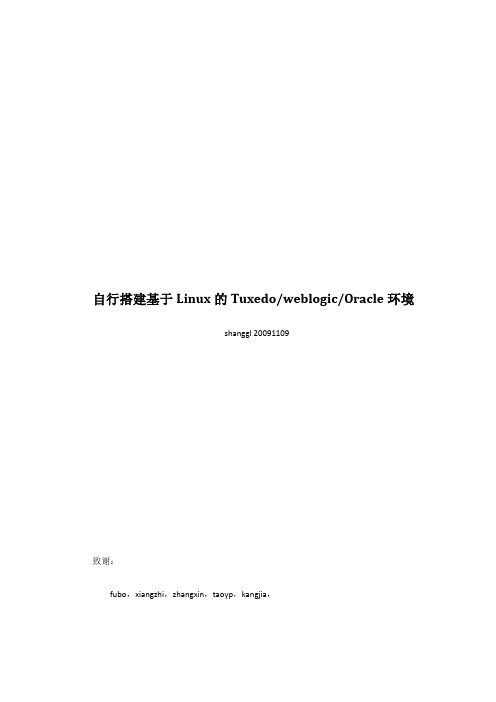
自行搭建基于Linux的Tuxedo/weblogic/Oracle环境shanggl 20091109致谢:fubo,xiangzhi,zhangxin,taoyp,kangjia,为了熟悉生产环境的搭建过程,自己使用红帽Linux 5.2 和Linux下的Tuxedo8.1 自己搭建了一套系统。
在安装过程中碰到了很多问题,因此把过程总结下来和大家分享。
首先要做的是安装红帽Linux,我使用的是vmware 6.5 ,这个安装包在74共享主机的常用工具里有,没有的同事可以找我要。
另外我已经安装完了一套虚拟机系统,不想自己安装的同事可以直接使用虚拟机镜像。
其他资源:Linux:rhel-5.2-server-i386-dvd.iso 4GBTuxedo:tuxedo81_linux_as3_i386.bin 100MB 对应lic.txt 从195上拷贝Oracle10G:10201_database_linux32.zip 700MBWebLogic9.5:weblogicServer920_linux32.bin 600MB这些资源在74 系统工具下有个文件夹Linux+tuxedo+weblogic+oracle文件夹下全有。
上面的文件已经标明了文件大小,请大家先准备好至少20GB空间。
约定:1、终端可以是远程telnet终端,也可以是在图形界面下的虚拟终端2、除非有特殊说明,所有命令均为小写字母,最好自己亲自打,word自带自动更正功能让很多命令变成了大写。
3、Tuxedo 安装是安装Tuxedo系统,而实际上的Tuxedo=服务+配置文件即只需root安装tuxedo套件,其他用户只需配置自己的服务和配置文件即可。
首先新建一个虚拟机,在新建虚拟机时选择自定义,如果选择典型的话,有可能在分区的时候提示找不到硬件(硬件驱动没有)。
虚拟机的配置如下:安装Linux过程暂略,后面会补上详细的说明。
Tuxedo通讯方式解析(二)
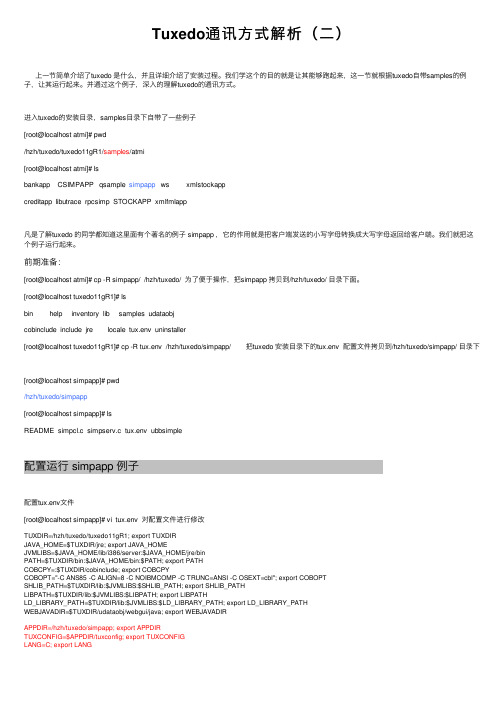
Tuxedo通讯⽅式解析(⼆)上⼀节简单介绍了tuxedo 是什么,并且详细介绍了安装过程。
我们学这个的⽬的就是让其能够跑起来,这⼀节就根据tuxedo⾃带samples的例⼦,让其运⾏起来。
并通过这个例⼦,深⼊的理解tuxedo的通讯⽅式。
进⼊tuxedo的安装⽬录,samples⽬录下⾃带了⼀些例⼦[root@localhost atmi]# pwd/hzh/tuxedo/tuxedo11gR1/samples/atmi[root@localhost atmi]# lsbankapp CSIMPAPP qsample simpapp ws xmlstockappcreditapp libutrace rpcsimp STOCKAPP xmlfmlapp凡是了解tuxedo 的同学都知道这⾥⾯有个著名的例⼦ simpapp ,它的作⽤就是把客户端发送的⼩写字母转换成⼤写字母返回给客户端。
我们就把这个例⼦运⾏起来。
前期准备:[root@localhost atmi]# cp -R simpapp/ /hzh/tuxedo/ 为了便于操作,把simpapp 拷贝到/hzh/tuxedo/ ⽬录下⾯。
[root@localhost tuxedo11gR1]# lsbin help inventory lib samples udataobjcobinclude include jre locale tux.env uninstaller[root@localhost tuxedo11gR1]# cp -R tux.env /hzh/tuxedo/simpapp/ 把tuxedo 安装⽬录下的tux.env 配置⽂件拷贝到/hzh/tuxedo/simpapp/ ⽬录下[root@localhost simpapp]# pwd/hzh/tuxedo/simpapp[root@localhost simpapp]# lsREADME simpcl.c simpserv.c tux.env ubbsimple配置运⾏ simpapp 例⼦配置tux.env⽂件[root@localhost simpapp]# vi tux.env 对配置⽂件进⾏修改TUXDIR=/hzh/tuxedo/tuxedo11gR1; export TUXDIRJAVA_HOME=$TUXDIR/jre; export JAVA_HOMEJVMLIBS=$JAVA_HOME/lib/i386/server:$JAVA_HOME/jre/binPATH=$TUXDIR/bin:$JAVA_HOME/bin:$PATH; export PATHCOBCPY=:$TUXDIR/cobinclude; export COBCPYCOBOPT="-C ANS85 -C ALIGN=8 -C NOIBMCOMP -C TRUNC=ANSI -C OSEXT=cbl"; export COBOPTSHLIB_PATH=$TUXDIR/lib:$JVMLIBS:$SHLIB_PATH; export SHLIB_PATHLIBPATH=$TUXDIR/lib:$JVMLIBS:$LIBPATH; export LIBPATHLD_LIBRARY_PATH=$TUXDIR/lib:$JVMLIBS:$LD_LIBRARY_PATH; export LD_LIBRARY_PATHWEBJAVADIR=$TUXDIR/udataobj/webgui/java; export WEBJAVADIRAPPDIR=/hzh/tuxedo/simpapp; export APPDIRTUXCONFIG=$APPDIR/tuxconfig; export TUXCONFIGLANG=C; export LANG配置ubbsimple ⽂件[root@localhost simpapp]# hostname //查看本机hostnamenode1[root@localhost simpapp]# vi ubbsimple# (c) 2003 BEA Systems, Inc. All Rights Reserved.#ident "@(#) samples/atmi/simpapp/ubbsimple $Revision: 1.7 $"#Skeleton UBBCONFIG file for the TUXEDO Simple Application.#Replace the <bracketed> items with the appropriate values.*RESOURCES#IPCKEY <Replace with a valid IPC Key>#Example:IPCKEY 123456DOMAINID simpappMASTER simpleMAXACCESSERS 10MAXSERVERS 5MAXSERVICES 10MODEL SHMLDBAL N*MACHINESDEFAULT:APPDIR="/hzh/tuxedo/simpapp"TUXCONFIG="/hzh/tuxedo/simpapp/tuxconfig"TUXDIR="/hzh/tuxedo/tuxedo11gR1"#Example:# APPDIR="/home/me/simpapp"# TUXCONFIG="/home/me/simpapp/tuxconfig"# TUXDIR="/usr/tuxedo"node1 LMID=simple //node1为本机hostname名#Example:#beatux LMID=simple*GROUPSGROUP1.......注意:APPDIR、TUXCONFIG和TUXDIR三个选项的路径要与 tux.env ⽂件中的配置保持⼀致。
tuxedo详细安装步骤
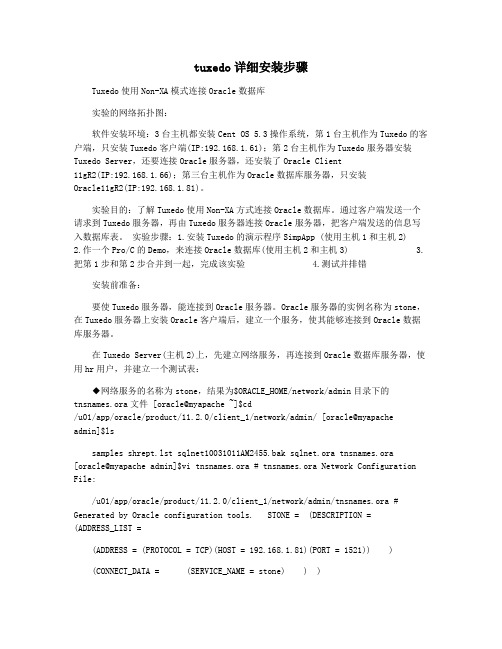
tuxedo详细安装步骤Tuxedo使用Non-XA模式连接Oracle数据库实验的网络拓扑图:软件安装环境:3台主机都安装Cent OS 5.3操作系统,第1台主机作为Tuxedo的客户端,只安装Tuxedo客户端(IP:192.168.1.61);第2台主机作为Tuxedo服务器安装Tuxedo Server,还要连接Oracle服务器,还安装了Oracle Client11gR2(IP:192.168.1.66);第三台主机作为Oracle数据库服务器,只安装Oracle11gR2(IP:192.168.1.81)。
实验目的:了解Tuxedo使用Non-XA方式连接Oracle数据库。
通过客户端发送一个请求到Tuxedo服务器,再由Tuxedo服务器连接Oracle服务器,把客户端发送的信息写入数据库表。
实验步骤:1.安装Tuxedo的演示程序SimpApp (使用主机1和主机2) 2.作一个Pro/C的Demo,来连接Oracle数据库(使用主机2和主机3) 3.把第1步和第2步合并到一起,完成该实验 4.测试并排错安装前准备:要使Tuxedo服务器,能连接到Oracle服务器。
Oracle服务器的实例名称为stone,在Tuxedo服务器上安装Oracle客户端后,建立一个服务,使其能够连接到Oracle数据库服务器。
在Tuxedo Server(主机2)上,先建立网络服务,再连接到Oracle数据库服务器,使用hr用户,并建立一个测试表:◆网络服务的名称为stone,结果为$ORACLE_HOME/network/admin目录下的tnsnames.ora文件 [oracle@myapache ~]$cd/u01/app/oracle/product/11.2.0/client_1/network/admin/ [oracle@myapacheadmin]$lssamples shrept.lst sqlnet10031011AM2455.bak sqlnet.ora tnsnames.ora[oracle@myapache admin]$vi tnsnames.ora # tnsnames.ora Network ConfigurationFile:/u01/app/oracle/product/11.2.0/client_1/network/admin/tnsnames.ora #Generated by Oracle configuration tools. STONE = (DESCRIPTION =(ADDRESS_LIST =(ADDRESS = (PROTOCOL = TCP)(HOST = 192.168.1.81)(PORT = 1521)) )(CONNECT_DATA = (SERVICE_NAME = stone) ) )◆建立测试表[oracle@myapache ~]$sqlplus hr/hr@stoneSQL*Plus: Release11.2.0.1.0 Production on Wed Mar 10 21:17:22 2021Copyright (c) 1982, 2021, Oracle. All rights reserved.Connected to:Oracle Database11gEnterpriseEdition Release11.2.0.1.0 - Production Withthe Partitioning, OLAP, Data Mining and Real Application Testing optionsSQL>create table t_test1( 2 zj number, 3 name varchar2(20) 4 ); Tablecreated.SQL>insert into t_test1 values(1, 'aaa'); 1 row created.SQL>commit; Commit complete.SQL>select * from t_test1; ZJ NAME ---------- -------------------- 1 aaa SQL>◆在主机2上还要把Oracle用户的环境变量设置好,使其能正确编译pro/c程序[oracle@myapache ~]$ vi .bash_profile设置好以下环境变量# User specific environment and startup programsORACLE_HOME=/u01/app/oracle/product/11.2.0/client_1 export ORACLE_HOMELD_LIBRARY_PATH=$ORACLE_HOME/libLD_LIBRARY_PATH=${LD_LIBRARY_PATH}:$ORACLE_HOME/oracm/libLD_LIBRARY_PATH=${LD_LIBRARY_PATH}:/lib:/usr/lib:/usr/local/lib exportLD_LIBRARY_PATHPATH=$PATH:$ORACLE_HOME/bin export PATHstty erase ^H (完)测试一下Pro/C是否正确 [oracle@myapache ~]$procPro*C/C++: Release11.2.0.1.0 - Production on Thu Mar 11 01:16:42 2021Copyright (c) 1982, 2021, Oracle and/or its affiliates. All rightsreserved.System default option values taken from:/u01/app/oracle/product/11.2.0/client_1/precomp/admin/pcscfg.cfg(下面内容从略)一、安装Tuxedo的演示程序SimpApp,并完成Tuxedo客户端访问服务器的配置1.在主机2上安装Tuxedo10gR3 Server建议采用字符安装界面,在安装过程中选择安装上Sample,以便运行SimpApp例子[root@myapache ~]#cd /home/OraFile/[root@myapache OraFile]#unzip tuxedo10gR3_32_Linux_01_x86.zip[root@myapache OraFile]#chmod +x tuxedo10gR3_32_Linux_01_x86.bin[root@myapache OraFile]#./tuxedo10gR3_32_Linux_01_x86.bin -i console Extracting the JRE from the installer archive... Unpacking the JRE...Extracting the installation resources from the installer archive... Configuring the installer for this system's environment...Launching installer... (比较重要的地方) Choose Oracle Home ------------------1- Create new Oracle HomeEnter a number:1Specify a new Oracle Home directory:/bea感谢您的阅读,祝您生活愉快。
tuxedo管理命令之tmboot与tmshutdown

tuxedo管理命令之tmboot与tmshutdown tuxedo管理命令之tmboot与tmshutdown [转贴 2009-09-26 15:50:15]字号:⼤中⼩tmboot命令启动TUXEDO系统的应⽤,创建必要的IPC资源、启动相关机器的规定的系统和应⽤服务进程。
tm的主要参数有:-A 启动所有机器上的管理进程。
-M 启动主控机器上的管理进程。
-i srvid 启动服务id等于srvid的进程。
-g grpname 启动指定的⼀组服务(含TMS)。
-S 启动所有应⽤服务。
-s server-name 启动可执⾏⽂件名为server-name的服务。
-e 打印本配置所需要的最少的IPC资源。
⽰例:tmboot -s s1104Cfm;s1104Cfm为服务名。
tmshutdown命令⽤于关闭所有或部分应⽤并释放IPC资源。
本命令所有参数与tmboot类似(如:-A,-g,-i,-s,-S),意义相同。
tmshutdown的特殊参数有:-c当有客户端正在连接时,tmshutdown不能关闭管理服务。
参数-c则可以超越次规则。
该参数仅⽤于管理员需要⽴即关机⽽⼜⽆法及时通知客户端时。
-P在⾮主控节点上,可以⽤-P参数仅关闭该机器上的应⽤。
⽰例:tmboot -s s1104Cfm;s1104Cfm为服务名。
~~~~~~~~~~~~~~~~~~~~~~~~~~~~~~~~~~~~~~~~~~~~~~~~~~~~~~~~~~~~~~以下是BEA的官⽅参考⽂档:/tuxedo/tux80/atmi/rfcmd31.htmtmbootNametmboot—Brings up a BEA Tuxedo configuration.Synopsistmboot [-l lmid] [-g grpname] [-i srvid] [-s aout] [-o sequence] [-S] [-A] [-b] [-B lmid] [-T grpname] [-e command] [-w] [-y] [-g] [-n] [-c] [-M] [-d1]Descriptiontmboot brings up a BEA Tuxedo application in whole or in part, depending on the options specified. tmboot can be invoked only by the administrator of the bulletin board (as indicated by the UID parameter in the configuration file) or by root. The tmboot command can be invoked only on the machine identified as MASTER in the RESOURCES section of the configuration file, or the backup acting as the MASTER, that is, with the DBBL already running (via the master command in tmadmin(1)). Except, if the -b option is used; in that case, the system can be booted from the backup machine without it having been designated as the MASTER.With no options, tmboot executes all administrative processes and all servers listed in the SERVERS section of the configuration file named by the TUXCONFIG and TUXOFFSET environment variables. If the MODEL is MP, a DBBL administrative server is started on the machine indicated by the MASTER parameter in the RESOURCES section. An administrative server (BBL) is started on every machine listed in the MACHINES section. For each group in the GROUPS section, TMS servers are started based on the TMSNAME and TMSCOUNT parameters for each entry. All administrative servers are started followed by servers in the SERVERS sections. Any TMS or gateway servers for a group are booted before the first application server in the group is booted. The TUXCONFIG file is propagated to remote machines as necessary. tmboot normally waits for a booted process to complete its initialization (that is, tpsvrinit()) before booting the next process.Booting a gateway server implies that the gateway advertises its administrative service, and alsoadvertises the application services representing the foreign services based on the CLOPT parameter for the gateway. If the instantiation has the concept of foreign servers, these servers are booted by the gateway at this time.Booting an LMID is equivalent to booting all groups on that LMID.Application servers are booted in the order specified by the SEQUENCE parameter, or in the order of server entries in the configuration file (see the description in UBBCONFIG(5)). If two or more servers in the SERVERS section of the configuration file have the same SEQUENCE parameter, then tmboot may boot these servers in parallel and will not continue until they all complete initialization. Each entry in the SERVERS section can have a MIN and MAX parameter. tmboot boots MIN application servers (the default is 1 if MIN is not specified for the server entry) unless the -i option is specified; using the -i option causes individual servers to be booted up to MAX occurrences.If a server cannot be started, a diagnostic is written on the central event log (and to the standard output, unless -q is specified), and tmboot continues—except that if the failing process is a BBL, servers that depend on that BBL are silently ignored. If the failing process is a DBBL, tmboot ignores the rest of the configuration file. If a server is configured with an alternate LMID and fails to start on its primary machine, tmboot automatically attempts to start the server on the alternate machine and, if successful, sends a message to the DBBL to update the server group section of TUXCONFIG.For servers in the SERVERS section, only CLOPT, SEQUENCE, SRVGRP, and SRVID are used by tmboot. Collectively, these are known as the server's boot parameters. Once the server has been booted, it reads the configuration file to find its run-time parameters. (See UBBCONFIG(5) for a description of all parameters.)All administrative and application servers are booted with APPDIR as their current working directory. The value of APPDIR is specified in the configuration file in the MACHINES section for the machine on which the server is being booted.The search path for the server executables is APPDIR, followed by TUXDIR/bin, followed by /bin and/usr/bin, followed by any PATH specified in the ENVFILE for the MACHINE. The search path is used only if an absolute pathname is not specified for the server. Values placed in the server's ENVFILE are not used for the search path.When a server is booted, the variables TUXDIR, TUXCONFIG, TUXOFFSET, and APPDIR, with values specified in the configuration file for that machine, are placed in the environment. The environment variable LD_LIBRARY_PATH is also placed in the environment of all servers. Its value defaults to $APPDIR:$TUXDIR/lib:/lib:/usr/lib:lib> where is the value of the first LD_LIBRARY_PATH= line appearing in the machine ENVFILE. See UBBCONFIG(5) for a description of the syntax and use of the ENVFILE. Some Unix systems require different environment variables. For HP-UX systems, use the SHLIB_PATH environment variable. FOR AIX systems, use the LIBPATH environment variable.The ULOGPFX for the server is also set up at boot time based on the parameter for the machine in the configuration file. If not specified, it defaults to $APPDIR/ULOG.All of these operations are performed before the application initialization function, tpsvrinit(), is called. Many of the command line options of tmboot serve to limit the way in which the system is booted and can be used to boot a partial system. The following options are supported.-l lmidFor each group whose associated LMID parameter is lmid, all TMS and gateway servers associated with the group are booted and all servers in the SERVERS section associated with those groups are executed. -g grpnameAll TMS and gateway servers for the group whose SRVGRP parameter is grpname are started, followed by all servers in the SERVERS section associated with that group. TMS servers are started based on the TMSNAME and TMSCOUNT parameters for the group entry.-i srvidAll servers in the SERVERS section whose SRVID parameter is srvid are executed.-s aoutAll servers in the SERVERS section with name aout are executed. This option can also be used to boot TMS and gateway servers; normally this option is used in this way in conjunction with the -g option.-o sequenceAll servers in the SERVERS section with SEQUENCE parameter sequence are executed.-SAll servers in the SERVERS section are executed.-AAll administrative servers for machines in the MACHINES section are executed. Use this option to guarantee that the DBBL and all BBL and BRIDGE processes are brought up in the correct order. (See also the description of the -M option.)-bBoot the system from the BACKUP machine (without making this machine the MASTER).-B lmidA BBL is started on a processor with logical name lmid.-MThis option starts administrative servers on the master machine. If the MODEL is MP, a DBBL administrative server is started on the machine indicated by the MASTER parameter in the RESOURCES section. A BBL is started on the MASTER machine, and a BRIDGE is started if the LAN option and a NETWORK entry are specified in the configuration file.-d1Causes command line options to be printed on the standard output. Useful when preparing to use sdb to debug application services.-T grpnameAll TMS servers for the group whose SRVGRP parameter is grpname are started (based on the TMSNAME and TMSCOUNT parameters associated with the group entry). This option is the same as booting based on the TMS server name (-s option) and the group name (-g).-e commandCauses command to be executed if any process fails to boot successfully. command can be any program, script, or sequence of commands understood by the command interpreter specified in the SHELL environment variable. This allows an opportunity to bail out of the boot procedure. If command contains white space, the entire string must be enclosed in quotes. This command is executed on the machine on which tmboot is being run, not on the machine on which the server is being booted.Note: If you choose to do redirection or piping on a Windows 2000 system, you must use one of the following methods:Do redirection or piping from within a command file or script.To do redirection from within the queue manager administration program, precede the command with cmd. For example:cmd /c ipconfig > out.txtIf you choose to create a binary executable, you must allocate a console within the binary executable using the Windows AllocConsole() API function-wInforms tmboot to boot another server without waiting for servers to complete initialization. This option should be used with caution. BBLs depend on the presence of a valid DBBL; ordinary servers require a running BBL on the processor on which they are placed. These conditions cannot be guaranteed if servers are not started in a synchronized manner. This option overrides the waiting that is normally done when servers have sequence numbers.-yAssumes a yes answer to a prompt that asks if all administrative and server processes should be booted. (The prompt appears only when the command is entered with none of the limiting options.)-qSuppresses the printing of the execution sequence on the standard output. It implies -y.-nThe execution sequence is printed, but not performed.-cMinimum IPC resources needed for this configuration are printed.When the -l, -g, -i, -o, and -s options are used in combination, only servers that satisfy all qualifications specified are booted. The -l, -g, -s, and -T options cause TMS servers to be booted; the -l, -g, and -s options cause gateway servers to be booted; the -l, -g, -i, -o, -s, and -S options apply to application servers. Options that boot application servers fail if a BBL is not available on the machine.The -A, -M, and -B options apply only to administrative processes.The standard input, standard output, and standard error file descriptors are closed for all booted servers. Interoperabilitytmboot must run on the master node, which in an interoperating application must be the highest release available. tmboot detects and reports configuration file conditions that would lead to the booting of administrative servers such as Workstation listeners on sites that cannot support them.Portabilitytmboot is supported on any platform on which the BEA Tuxedo server environment is supported. Environment VariablesDuring the installation process, an administrative password file is created. When necessary, the BEA Tuxedo system searches for this file in the following directories (in the order shown):APPDIR/.adm/tlisten.pw and TUXDIR/udataobj/tlisten.pw. To ensure that your password file will be found, make sure you have set the APPDIR and/or TUXDIR environment variables.Link-Level EncryptionIf the link-level encryption feature is in operation between tmboot and tlisten, link-level encryption will be negotiated and activated first to protect the process through which messages are authenticated. DiagnosticsIf TUXCONFIG is set to a non-existent file, two fatal error messages are displayed:error processing configuration fileconfiguration file not foundIf tmboot fails to boot a server, it exits with exit code 1 and the user log should be examined for further details. Otherwise tmboot exits with exit code 0.If tmboot is run on an inactive non-master node, a fatal error message is displayed:tmboot cannot run on a non-master node.If tmboot is run on an active node that is not the acting master node, the following fatal error message is displayed:tmboot cannot run on a non acting-master node in an active application.If the same IPCKEY is used in more than one TUXCONFIG file, tmboot fails with the following message: Configuration file parameter has been changed since last tmbootIf there are multiple node names in the MACHINES section in a non-LAN configuration, the following fatal error message is displayed:Multiple nodes not allowed in MACHINES for non-LAN application.If tlisten is not running on the MASTER machine in a LAN application, a warning message is printed. In this case, tmadmin(1) cannot run in administrator mode on remote machines; it is limited to read-only operations. This also means that the backup site cannot reboot the master site after failure.ExamplesTo start only those servers located on the machines logically named CS0 and CS1, enter the following command:tmboot -l CS0 -l CS1To start only those servers named CREDEB that belong to the group called DBG1, enter the following command:tmboot -g DBG1 -s CREDEB1To boot a BBL on the machine logically named PE8, as well as all those servers with a location specified as PE8, enter the following command.tmboot -B PE8 -l PE8To view minimum IPC resources needed for the configuration, enter the following command.tmboot -cThe following is an example of the output produced by the -c option:Ipc sizing (minimum BEA Tuxedo values only) ... Fixed Minimums Per Processor SHMMIN: 1 SHMALL: 1 SEMMAP: SEMMNI Variable Minimums Per Processor SEMUME, A SHMMAX SEMMNU, * * Node SEMMNS SEMMSL SEMMSL SEMMNI MSGMNI MSGMAP SHMSEG ------ ------ ------ ------ ------ ------ ------ ------ sfpup 60 1 60 A + 1 10 20 76K sfsup 63 5 63 A + 1 11 22 76K where 1 = A = 8.The number of expected application clients per processor should be added to each MSGMNI value. MSGMAP should be twice MSGMNI. SHMMIN should always be set to 1.The minimum IPC requirements can be compared to the parameters set for your machine. See the system administration documentation for your machine for information about how to change these parameters. If the -y option is used, the display will differ slightly from the previous example.NoticesThe tmboot command ignores the hangup signal (SIGHUP). If a signal is detected during boot, the process continues.Minimum IPC resources displayed with the -c option apply only to the configuration described in the configuration file specified; IPC resources required for a resource manager or for other BEA Tuxedo configurations are not considered in the calculation.See Alsotmadmin(1), tmloadcf(1), tmshutdown(1), UBBCONFIG(5)Administering BEA Tuxedo Applications at Run Time------------------------------------tmshutdown以下是BEA的官⽅参考⽂档:/tuxedo/tux80/atmi/rfcmd35.htm#1335246 tmshutdown(1)Nametmshutdown—Shuts down a set of BEA Tuxedo servers.Synopsistmshutdown [options]Descriptiontmshutdown stops the execution of a set of servers or removes the advertisements of a set of services listed in a configuration file. Only the administrator of the bulletin board (as indicated by the UID parameter in the configuration file) or root can invoke the tmshutdown command. tmshutdown can be invoked only on the machine identified as MASTER in the RESOURCES section of the configuration file, or the backup acting as the MASTER, that is, with the DBBL already running (via the master command in tmadmin(1)). An exception to this is the -P option which is used on partitioned processors (see below). With no options, tmshutdown stops all administrative, TMS, and gateway servers, and servers listed in the SERVERS section of the configuration file named by the TUXCONFIG environment variable, and removes the IPC resources associated with them. For each group, all servers in the SERVERS section, if any, are shut down, followed by any associated gateway servers (for foreign groups) and TMS servers. Administrative servers are shut down last.Application servers without SEQUENCE parameters are shut down first in reverse order of the server entries in the configuration file, followed by servers with SEQUENCE parameters that are shut down from high to low sequence number. If two or more servers in the SERVERS section of the configuration file have the same SEQUENCE parameter, then tmshutdown may shut down these servers in parallel. Each entry in the SERVERS section may have an optional MIN and MAX parameter. tmshutdown shuts down all occurrences of a server (up to MAX occurrences) for each server entry, unless the -i option is specified; using the -i option causes individual occurrences to be shut down.If it is not possible to shut down a server, or remove a service advertisement, a diagnostic is written on the central event log (see userlog(3c)). The following is a description of all options:-l lmidFor each group whose associated LMID parameter is lmid, all servers in the SERVERS section associated with the group are shut down, followed by any TMS and gateway servers associated with the group.-g grpnameAll servers in the SERVERS section associated with the specified group (that is, for which the SRVGRP parameter is set to grpname) are shut down, followed by all TMS and gateway servers for the group. TMSservers are shut down based on the TMSNAME and TMSCOUNT parameters for the group entry. For a foreign group, the gateway servers for the associated entry in the HOST section are shut down based on GATENAME and GATECOUNT. Shutting down a gateway implies not only that the process itself is stopped; it also implies that the administrative service for the gateway and all advertised foreign services are unadvertised.-i srvidAll servers in the SERVERS section for which the SRVID parameter is set to srvid are shut down. Do not enter a value for SRVID greater than 30,000; this indicates system processes (that is, TMSs or gateway servers) that should only be shut down via the -l or -g option.-s aoutAll servers listed in the SERVERS section with the name aout are shut down. This option can also be used to shut down TMS and gateway servers.-o sequenceAll servers in the SERVERS section for which the SEQUENCE parameter is set to sequence are shut down.-SAll servers listed in the SERVERS section are shut down.-AAll administrative servers are shut down.-MThis option shuts down administrative servers on the master machine. The BBL is shut down on the MASTER machine, and the BRIDGE is shut down if the LAN option and a NETWORK entry are specified in the configuration file. If the MODEL is MP, the DBBL administrative server is shut down.-B lmidThe BBL on the processor with the logical name lmid is shut down.-T grpnameAll TMS servers for the server group for which the SRVGRP parameter is set to grpname are shut down (based on the TMSNAME and TMSCOUNT parameters associated with the server group entry).-w delayTells tmshutdown to suspend all selected servers immediately and waits for shutdown confirmation for only delay seconds before forcing the server to shut down by sending a SIGTERM and then a SIGKILL signal to the server.Because the SIGKILL signal cannot be trapped, any process that receives it is terminated immediately, regardless of the code being executed by the process at that time. Such behavior may cause structural damage to the bulletin board if the process being stopped was updating the bulletin board when it was terminated.Note: Servers to which the -w option may be applied should not catch the UNIX signal SIGTERM.Note: When a server is shut down based on receipt of a SIGKILL signal, entries may remain in the bulletin board. When the bulletin board liaison (BBL) is due to shut down, these entries are detected and the BBL does not shut down. A second tmshutdown command may be required to complete system shutdown.-k {TERM | KILL}tmshutdown suspends all selected servers immediately and forces them to shut down in an orderly fashion (TERM) or preemptively (KILL).Because the SIGKILL signal cannot be trapped, any process that receives it is terminated immediately, regardless of the code being executed by the process at that time. Such behavior may cause structural damage to the bulletin board if the process being stopped was updating the bulletin board when it was terminated.Note: This option maps to the UNIX signals SIGTERM and SIGKILL on platforms that support them. By default, a SIGTERM initiates an orderly shutdown in a BEA Tuxedo server. If SIGTERM is reset by an application, the BEA Tuxedo system may be unable to shut down the server.Note: When a server is shut down based on receipt of a SIGKILL signal, entries may remain in the bulletin board. When the bulletin board liaison (BBL) is due to shut down, these entries are detected and the BBLdoes not shut down. A second tmshutdown command may be required to complete system shutdown.-yAssumes a yes answer to a prompt that asks whether all administrative and server processes should be shut down. (The prompt appears only when the command is entered with none of the limiting options.)When the -y option is specified, all services are unadvertised immediately from the bulletin board and any subsequent service calls fail.-qSuppresses the printing of the execution sequence on standard output. It implies -y.-nThe execution sequence is printed, but not performed.-RFor migration operations only, shuts down a server on the original processor without deleting its bulletin board entry in preparation for migration to another processor. The -R option must be used with either the -l or -g option (for example, tmshutdown -l lmid -R). The MIGRATE option must be specified in the RESOURCES section of the configuration file.-cShuts down BBLs even if clients are still attached.-H lmidOn a uniprocessor, all administrative and applications servers on the node associated with the specified lmid are shut down. On a multiprocessor (for example, 3B4000), all PEs are shut down, even if only one PE is specified.-P lmidWith this option, tmshutdown attaches to the bulletin board on the specified lmid, ensures that this lmid is partitioned from the rest of the application (that is, that it does not have access to the DBBL), and shuts down all administrative and application servers. It must be run on the processor associated with the lmid in the MACHINES section of the configuration file.The -l, -g, -s, and -T options cause TMS servers to be shut down; the -l, -g, and -s options cause gateway servers to be shut down; the -l, -g, -i, -s, -o, and -S options apply to application servers; the -A, -M, and -B options apply only to administrative processes. When the -l, -g, -i, -o, and -s options are used in combination, only servers that satisfy all the qualifications specified are shut down.If the distributed transaction processing feature is being used such that global transactions are in progress when servers are shut down, transactions that have not yet reached the point at which a commit is logged after a precommit are aborted; transactions that have reached the commit point are completed when the servers (for example, TMS) are booted again.Interoperabilitytmshutdown must run on the master node. In an interoperating application the master node must be running the highest release available. tmshutdown detects and reports configuration file conditions that would lead to the shutting down of Release 4.2 administrative servers on Release 4.1 sites.Portabilitytmshutdown is supported on any platform on which the BEA Tuxedo server environment is supported.DiagnosticsIf tmshutdown fails to shut down a server or if a fatal error occurs, tmshutdown exits with exit code 1 and the user log should be examined for further details; otherwise it exits with exit code 0.If tmshutdown is run on an active node that is not the acting master node, a fatal error message is displayed:tmshutdown cannot run on a non acting-master node in an active application.If shutting down a process would partition active processes from the DBBL, a fatal error message is displayed:cannot shutdown, causes partitioning.If a server has died, the following somewhat ambiguous message is produced.CMDTUX_CAT:947 Cannot shutdown server GRPIDExamplesTo shut down the entire system and remove all BEA Tuxedo IPC resources (force it if confirmation is not received in 30 seconds), run the following command:tmshutdown -w 30To shut down only those servers located on the machine for which the value of lmid is CS1, enter the following command:tmshutdown -l CS1Because the -l option restricts the action to servers listed in the SERVERS section, the BBL on CS1 is not shut down.NoticesThe tmshutdown command ignores the hangup signal (SIGHUP). If a signal is detected during shutdown, the process continues.See Alsotmadmin(1), tmboot(1), UBBCONFIG(5)Administering BEA Tuxedo Applications at Run Time。
- 1、下载文档前请自行甄别文档内容的完整性,平台不提供额外的编辑、内容补充、找答案等附加服务。
- 2、"仅部分预览"的文档,不可在线预览部分如存在完整性等问题,可反馈申请退款(可完整预览的文档不适用该条件!)。
- 3、如文档侵犯您的权益,请联系客服反馈,我们会尽快为您处理(人工客服工作时间:9:00-18:30)。
一、登记中心主机:a)配置文件一般的配置文件在~/etc下的ubb.txt,如下是文件的内容,红色部分是要针对环境进行修改的,紫色部分是为了环境管理方便可以选择来修改的。
配置文件ubb.txt的内容如下:*RESOURCESIPCKEY 174842DOMAINID ccbdmHQMASTER ccbdjzxMAXACCESSERS 600MAXSERVERS 300MAXSERVICES 900MODEL MPOPTIONS LANLDBAL N*MACHINESDEFAULT:Apsvr1 LMID=ccbdjzxUID=136 GID=102APPDIR="/data/ccbsbs/bin"TUXCONFIG="/data/ccbsbs/etc/tuxconfig"TUXDIR="/usr/tuxedo"ULOGPFX="/data/ccbsbs/log/ULOG"MAXWSCLIENTS=3scosysv LMID=ccbgw1UID=113 GID=102APPDIR="/ usr /ccbsbs/bin"TUXCONFIG="/ usr /ccbsbs/etc/tuxconfig"ENVFILE="/ usr /ccbsbs/etc/envfile"ULOGPFX="/ usr /ccbsbs/log/ULOG"TUXDIR="/usr/tuxedo"Gateway3 LMID=ccbgw2UID=105 GID=102APPDIR="/ usr /ccbsbs/bin"TUXCONFIG="/ usr /ccbsbs/etc/tuxconfig"ENVFILE="/ usr /ccbsbs/etc/envfile"ULOGPFX="/ usr /ccbsbs/log/ULOG"TUXDIR="/usr/tuxedo"*GROUPSccbGHQaLMID=ccbdjzx GRPNO=1 OPENINFO=NONEccbGHQbLMID=ccbdjzx GRPNO=2 OPENINFO=NONE ccbGHQcLMID=ccbdjzx GRPNO=3 OPENINFO=NONE ccbGgwaLMID=ccbgw1 GRPNO=21 OPENINFO=NONE ccbGgwbLMID=ccbgw1 GRPNO=22 OPENINFO=NONE ccbGgwcLMID=ccbgw1 GRPNO=23 OPENINFO=NONE ccbGgw2aLMID=ccbgw2 GRPNO=31 OPENINFO=NONE ccbGgw2bLMID=ccbgw2 GRPNO=32 OPENINFO=NONE ccbGgw2cLMID=ccbgw2 GRPNO=33 OPENINFO=NONE *NETWORKccbdjzxNADDR="//192.168.1.11:8400"BRIDGE="/dev/tcp"NLSADDR="//192.168.1.11:8401"ccbgw1NADDR="//192.168.1.21:8400"BRIDGE="/dev/tcp"NLSADDR="//192.168.1.21:8401"Ccbgw2NADDR="//192.168.1.22:8400"BRIDGE="/dev/tcp"NLSADDR="//192.168.1.22:8401"*SERVERSDEFAULT: CLOPT="-A"RB26SYSM SRVGRP=ccbGHQa SRVID=1RB20CUST SRVGRP=ccbGHQa SRVID=2RB22ACIF SRVGRP=ccbGHQa SRVID=3RB24FUND SRVGRP=ccbGHQa SRVID=4RB21CARD SRVGRP=ccbGHQa SRVID=5RB25OTHE SRVGRP=ccbGHQa SRVID=6RB23SECU SRVGRP=ccbGHQa SRVID=7 PAccount SRVGRP=ccbGHQa SRVID=8 TransAccount SRVGRP=ccbGHQa SRVID=9 onlinetrade SRVGRP=ccbGHQa SRVID=11CheckServ SRVGRP=ccbGHQa SRVID=12batchsv SRVGRP=ccbGHQa SRVID=13dispatch SRVGRP=ccbGHQa SRVID=14simpserv SRVGRP=ccbGHQa SRVID=119ftpserv32 SRVGRP=ccbGHQb SRVID=129WSL SRVGRP=ccbGHQb SRVID=10CLOPT="-A -- -n//192.168.42.HQ:8420 -m1 -M3 -x1"DMADM SRVGRP=ccbGHQb SRVID=101GWADM SRVGRP=ccbGgwa SRVID=105GWTDOMAIN SRVGRP=ccbGgwa SRVID=109ordertest SRVGRP=ccbGgwb SRVID=21gwreadfs SRVGRP=ccbGgwb SRVID=31gwrecv SRVGRP=ccbGgwb SRVID=41gwfundsvr SRVGRP=ccbGgwb SRVID=51*SERVICESTUXFTP ROUTING=ftproutGWFUNDSVR ROUTING=agent*ROUTINGftprout FIELD=FTPROUTE BUFTYPE="FML32"RANGES="'001':ccbGHQb,*:ccbGgwa"Agent FIELD=ROUTINGFLD BUFTYPE="FML32"RANGES="'00a':ccbGgwb,*:ccbGgwb"b)环境变量一般的环境变量设置文件为在~/etc下的setenv,如下是文件的内容,红色部分是要针对环境进行修改的,紫色部分是为了应用系统和数据库来设定的。
环境变量设置文件setenv的内容如下:TUXDIR=/home/tuxedo; export TUXDIRPATH=$TUXDIR/bin:$PATH:$HOME/bin:.; export PATHSHLIB_PATH=$TUXDIR/lib:/usr/lib:/lib;export SHLIB_PATHNLSPATH=$TUXDIR/locale;export NLSPATHLANG=C;export LANGTUXCONFIG=/data/ccb/etc/tuxconfig;export TUXCONFIGBDMCONFIG=/data/ccb/etc/bdmconfig;export BDMCONFIGFIELDTBLS32=ftpflds;export FIELDTBLS32FLDTBLDIR32=$TUXDIR/api105;export FLDTBLDIR32tlisten -d /dev/tcp -l //192.168.42.HQ:8401ORACLE_BASE=/oracleexport ORACLE_BASEORACLE_HOME=/oracle/app/oracle/product/8.1.6export ORACLE_HOMEORACLE_SID=ora816export ORACLE_SIDLD_LIBRARY_PATH=$ORACLE_HOME/lib:$ORACLE_HOME/rdbms/libORACLE_TERM=vt100PATH=$ORACLE_HOME/bin:$PATHexport ORACLE_TERM LD_LIBRARY_PATH PATHSHLIB_PATH=$ORACLE_HOME/lib:/usr/lib:$SHLIB_PATHexport SHLIB_PATHNLS_LANG=American_America.ZHS16GBK;export NLS_LANGc)配置文件一般的配置文件在~/etc下的dm.txt,如下是文件的内容,红色部分是要针对环境进行修改的,绿色部分是为了环境管理方便可以选择来修改的,如果再登记中心的主机上作了相应的修改,那么紫色的部分必须作相应的修改。
配置文件dm.txt的内容如下:*DM_LOCAL_DOMAINSccbdmHQ GWGRP=ccbGgwaTYPE=TDOMAINDOMAINID=ccbdmHQ*DM_REMOTE_DOMAINSccbdm231 TYPE=TDOMAINDOMAINID=ccbdm231ccbdm220 TYPE=TDOMAINDOMAINID=ccbdm220*DM_TDOMAINccbdm231 NWADDR="//192.168.42.231:8410"NWDEVICE="/dev/tcp"ccbdm220 NWADDR="//192.168.42.220:8410"NWDEVICE="/dev/tcp"ccbdmHQ NWADDR="//192.168.42.138:8410"NWDEVICE="/dev/tcp"*DM_LOCAL_SERVICESRS0801REGNETWSRS0802DELNETWSRS0803MODINETWSRS0001OPENMANRS0002OPENGRPRS0005MODICARDRS0006MODIMANRS0007MODIGRPRS0011OPENACRS0013REGOACRS0201MTRANINRS0202MTRANOUTRS0031CHGCARDRS0029RECARDRS0101ACFRZRS0026CARDLOSERS0030CCPWLOSERS0022PWDLOSERS0103ACFRZRS0107MFRZRS0108MNOFRZRS0104ACNOFRZRS0203CASHINRS0102ACNOFRZRS0204CASHOUTRS0205DAYCWCRS0112DEDUCTRS0721AGLOGINRS0722AGLOGOUTRS0043TRANSINRS0044TRANSOUTRS0042CHGOWNRS0109SECFRZRS0110SECNOFRZRS0012DELACRS0014DELOACRS0004DELCUSTRS0003NDELCUSTRS0041OUTSYSHSJJTUXFTPTRADETOUPPERregisterDispatchDMac DispatchDetail DetailRequest*DM_REMOTE_SERVICES HSCJHB ROUTING=agent GETPRICES ROUTING=agentTUXFTP ROUTING=ftprout*DM_ROUTINGagent FIELD =ROUTINGFLD BUFTYPE ="FML32"RANGES ="'510':ccbdm231, '110':ccbdm220, *:ccbdm220"ftprout FIELD =FTPROUTE BUFTYPE ="FML32"RANGES ="'510':ccbdm231, '110':ccbdm220, *:ccbdm231"二、应用网关a)环境变量文件一般的环境变量设置文件为在~/etc下的envfile,如下是文件的内容,红色部分是要针对环境进行修改的。
